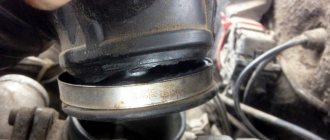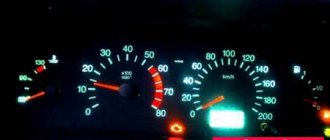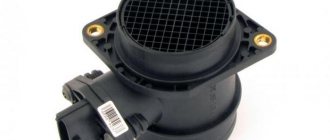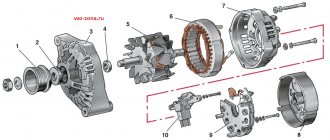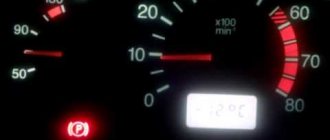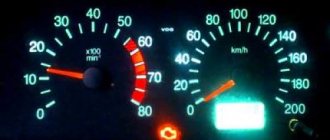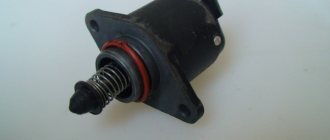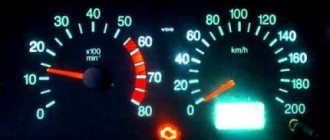Drivers’ complaints that whenever the engine heats up, strange things begin to happen with the speed (the so-called “floating effect”), it is not so rare to hear. This unpleasant incident is inherent in gasoline engines that have injection, carburetor formats, as well as engines running on diesel fuel. If, when the engine warms up, the speed suddenly slows down, this is a sure signal that something unexpected has happened to it and you need to immediately look for the cause and fix the problem.
Eliminating the problem of floating engine speed.
The reason for the appearance of floating speed
If the speed fluctuates on a warm engine under load or in idle mode, you should immediately carry out a comprehensive diagnosis of the car so as not to aggravate the situation. But at the initial stage of the study, it is advisable to understand the peculiarities of the floating speed. An ordinary tachometer will help to record this. If everything is fine with the engine, the tachometer will record stable readings at approximately the same level (about 800 rpm), without sudden jumps. However, if something is wrong with the engine, the range of tachometer readings will rapidly increase, ranging from 500 to 1500 revolutions per minute.
The presence of floating speed is also proven by the amount of engine rumble, which from time to time either increases or decreases. In addition, vibrations of varying strengths that change like a sine wave begin to be clearly felt inside the car from the engine. Such incidents are most often recorded during unstable engine speeds, which operate in idle mode.
However, tachometer “jumps” are sometimes observed during intermediate engine speeds, which is typical for diesel engines. If there are deviations from the norm, the tachometer may show a completely unimaginable speed range. For example, from 500 to 1000, and then to 1500 rpm, after which they rapidly fall, in the reverse order, to 500 rpm. This is clearly noticeable when the load on the engine increases:
- after pressing the brake pedal;
- rotation of a steering wheel equipped with a hydraulic booster;
- turning on the air conditioner;
- when driving transitional type and so on.
In such cases, the engine at idle, in the absence of excess load, manages to keep the speed stable, but as soon as it appears, the speed immediately drops and the engine almost stalls. Additional “noises” include an unreasonable increase in fuel consumption and other factors.
How to find the reason yourself?
Troubleshooting an injection engine should begin with computer diagnostics. There are cases when the engine stalls when cold, the speed fluctuates after warming up, but there are no current errors in the fault memory. In this case, you need to focus on actual performance. Using diagnostic equipment, you can monitor in real time the change in coolant temperature, compare the specified and actual position of the DS, and the number of IAC steps. The discrepancy between the required and actual responses is a compelling argument for a detailed check of the node.
Methods for solving the problem
Having detected a floating speed, experienced drivers begin checking the relevant electronics. During diagnostics, special attention is paid to the throttle assembly, as well as sensors and actuators. The operation of other mechanisms also needs to be diagnosed, including the ignition system and idle speed control, as well as air and fuel filters, injector nozzles, etc. There is especially a lot of hassle with the regulator and air flow sensor. Based on the results of a thorough diagnosis, it often turns out that the whole reason is a heavily contaminated throttle valve, which for this reason does not close as it should, or mechanical damage to the throttle. In the first case, careful cleaning of the valve immediately gives a positive result, but in the second case it is best to replace the throttle with a new one.
Is the EGR system on the injector working?
"Floating" speed can be caused by jamming of the exhaust gas recirculation (EGR) valve, which is installed in the exhaust manifold. It is necessary to periodically remove dirt from the valve seat and its seat using a carburetor cleaning aerosol, avoiding liquid getting on the sensor diaphragm.
Keep the valve seat clean
Attention! If cleaning the unit does not give a positive result, the device must be replaced.
IAC sensor
The cause of engine operation deviation from normal parameters may also be a malfunction of the idle air control sensor (IAC). The whole point is that in cars, as a rule, it is not supplemented by a self-monitoring system, so on-board computers or check-angers do not signal its breakdown. However, floating speed is one of the key signs of a malfunction of the IAC sensor, so it needs a thorough inspection and, if necessary, its repair or even replacement, especially since its cost is relatively low.
Idle mode
Idle speed is the operating mode of a car engine with the gear in neutral. It is characterized by minimal engine load and low fuel consumption.
Idle mode is used:
- for delivering motor oil from the engine crankcase to friction units after a long period of parking the vehicle;
- to warm up the power unit in the cold season;
- in cases where turning off the motor is impossible or undesirable.
During normal engine operation, the crankshaft speed is idling at 2000 rpm. gradually decrease to 800, then maintaining at this level. However, it also happens that the power plant, when switching to this mode, operates unstably - it randomly changes the speed in the range of 500–1500 rpm, “chokes” and stalls. This tells us: a failure has occurred in the engine control system, the causes of which must be diagnosed and eliminated as soon as possible.
The movement of the instrument needle shows a change in the number of engine revolutions.
Determining the specific cause that caused the malfunction is not easy, but it cannot be ignored - this can lead to critical engine failure and the need for expensive repair work. In addition, driving a car with an engine that is unstable at idle speed distracts the driver's attention. He has to constantly monitor changes in the speed and keep his foot on the gas pedal, preventing the engine from stalling when braking or stopping briefly.
Throttle valve
As noted above, increased idle speed of a car on a warm engine may be a consequence of the fact that the throttle valve is dirty. The dirt that has accumulated on it over time does not allow it to close freely and completely, as intended, so it must be thoroughly cleaned. At the same time, some drivers note with surprise that sometimes even thorough cleaning of the damper along with the idle air valve is not enough. So, the engine still maintains high speeds, and the brake pedal loses its elasticity, becoming very hard. Then, according to experts, you will have to start cleaning the VVTi valve. There are also recommendations to start flushing the idle air valve.
Unstable operation at medium and high speeds
It happens that the revolutions fluctuate while driving, that is, while the car is moving. At the same time, the car jerks and drives jerkily. Such movement is not only unpleasant, but also dangerous - there is a risk that someone will catch up and crash into you. There may be several reasons for such unstable operation:
- The air filter is clogged;
- Spark plugs are faulty;
- The lambda probe does not work;
- The catalyst is clogged;
- The exhaust valve in the engine has burnt out;
- The throttle position sensor has failed.
There may be other reasons; in complex cases, you cannot do without a good diagnostician.
Electronic control unit
According to the observations of experts, most often the phenomenon of floating speed at idle is inherent in injection-type engines, in which regulators “assigned” to it - electronic engine control units - are responsible for idling. They are designed to constantly analyze data on the functioning of the idle speed, and when failures occur, to give the appropriate mechanisms a command to correct the errors. Therefore, the cause of floating speed is often a breakdown in the electronics.
Having discovered the effect of floating speed in a car, the driver needs to take this seriously so that the situation does not worsen and does not lead to serious engine damage, and its large-scale repair, as we know, is always expensive. Therefore, it is better to conduct a thorough diagnosis of the car, and if in the process it is discovered which part or unit is faulty, replace it with new ones, after which the engine will work normally.
Jumps in engine speed: how to fix
Now let's talk about what a mechanically savvy vehicle owner can do.
Air leak
As we mentioned above, this phenomenon is observed under conditions of poor sealing. This is what needs to be checked first. You can remove each hose of the air supply line to the intake manifold individually and blow it out. To make the task easier, you can treat the hoses with WD-40. There will be a crack where the composition evaporates. It is better to replace the hose.
Idle speed control
The condition of this device is measured with a multimeter. It is necessary to take resistance readings; if they are in the range from 40 to 80 ohms, then replacement is required.
Crankcase ventilation valve
It has the ability to become dirty over time and affect engine speed. To clean the valve, you need to disassemble the oil sump and remove it. Washing in kerosene will get rid of oil sludge. After the procedure, you need to dry the spare part and install it back.
Replacing the air flow sensor
The mass air flow sensor is very delicate and cannot be repaired if it breaks. It can only be replaced.
Throttle valve
This case is typical for a mechanical damper drive. If it jams, then in order to correct the situation it must be removed and washed, and then installed back in the correct position. There is an option for washing without dismantling. For cleaning, a special aerosol is used, which can be found at any auto parts store.
Adjusting the engine idle speed
This should only be done if you are absolutely confident in your abilities. Auto service employees often have to correct the results of the actions of an inexperienced technician. The process is carried out using a screwdriver; it adjusts the screws for the quantity and quality of revolutions.
Carburetor solenoid valve
If this part of the installation is faulty, then the engine can only operate on air suction. Cannot be repaired, only replaced.
Idle jet
Drivers with extensive experience can say that cleaning this part is a very labor-intensive process. The statement has long lost its relevance; today there is no need to remove the jet in order to put it in order. A special cleaning agent is poured into it and left for a few minutes. Then the liquid is drained, and the remaining dirt is blown out by air pressure.
Treating fuel injection pump blades against corrosion
This procedure is also performed with a special cleaning composition. It is simply sprayed onto the neck of the fuel tank before refueling. No other action is required.
Now you know why the idle speed fluctuates and how you can correct the situation. But we want to repeat again, if such a phenomenon occurs, do not delay and be sure to contact the service station. This will allow you to solve the problem at an early stage and not aggravate the situation, which may lead to a significant increase in the cost of repairs. If you have any questions, write them in the comments. Share the article and stay with us.
Diesel engine: signs of malfunctions and possible causes
When operating a vehicle, malfunctions occur in the operation of the diesel engine, which can be identified by the following signs.
Difficulty starting the internal combustion engine
Injection is too early or late, which leads to an incorrect advance angle of the fuel supply.
Poor atomization of diesel fuel occurs due to worn parts. Airing of the fuel system causes a lack of diesel fuel in front of the fuel pump. The injection valves in the high pressure fuel pump are worn out. There are defects in the low pressure pump. The regulator does not work correctly, which minimizes the volume of incoming fuel when starting the power unit. Thickening of diesel fuel in winter. There were problems with the glow plugs. During injection, pressure arises that is insufficient for normal engine starting. Decrease in power of the power unit
The problem could arise due to an incorrect advance angle of the fuel supply.
The all-mode regulator and fuel pump are not adjusted correctly. Precision elements in the high-pressure fuel pump have worn out. Regulator wear. The nozzles are damaged and may wear out. The injection pressure drops below the permissible values. The injection system elements do not supply the required volume of fuel. Increased diesel fuel consumption
The injection advance angle is incorrect.
Nozzles are damaged or worn out. The injection pressure drops below the permissible values. Compression has decreased significantly. There is a fuel leak. The air filter is clogged. The high pressure fuel pump is not adjusted correctly. The injection valves in the fuel pump are worn out. The power unit is not working correctly. The exhaust gases are black.
Compression has decreased significantly.
The valves are not adjusted correctly. The injectors are unable to spray diesel fuel. In the combustion chamber, problems arise with the formation of the air-fuel mixture. Such disturbances may occur due to problems with valve closure (improper adjustment) or the occurrence of oxidized deposits. The color of the exhaust gases has changed to white or gray.
The injection timing is incorrectly set.
Compression has decreased significantly. There was a breakdown in the cylinder head gasket. The motor has become overcooled. The appearance of rigidity in engine operation.
An imbalance has appeared between the volumes of fuel entering the cylinders of the unit.
Some of the injectors are not working correctly. Compression has decreased significantly. Diesel fuel injection set too early. The engine is overheating.
The injectors are not spraying diesel fuel correctly.
The injection advance angle is set incorrectly. The engine does not develop maximum power.
The air filter is clogged.
Airing the vehicle. Problems with the operation of the high pressure fuel pump. The fuel injection advance angle is set incorrectly. Problems with injectors. Possible cause: faulty fastening of parts. The tightness of the fuel lines is broken. Problems with accelerator thrust adjustment. The noise level of the power unit has increased.
Airing of the fuel system.
Poor performance of sprayers. The power unit operates unevenly at idle.
The fuel injection advance angle is set incorrectly.
Problems with the gas pedal travel. Loose fuel line between the injection pump and the fuel filter. Problems with fuel supply. Nozzles and sprayers do not work correctly. Fluctuations in crankshaft speed
Misadjustment and wear of the injection system.
The speed controller is worn out. Airing the vehicle. Excessive gas pressure in the crankcase. Unexpected stop of the power unit
The fuel filter is clogged, the fuel supply to the high-pressure fuel pump is insufficient.
The fuel injection pump was damaged, which caused a cessation of fuel supply. The low pressure fuel pump has been damaged. The injection pipeline is damaged. The connection between the pump and the drive is broken. The separator piston is worn out and the part may become skewed. The rotor or pistons in the high pressure fuel pump may be worn. Glow plugs fail.
Such a malfunction can be caused by defective injectors.
It is impossible to turn off the power unit.
The solenoid valve has failed.
The oil level in the crankcase is rising.
The problem may arise due to an engine oil leak.
The injectors are not working correctly (“pouring”). Engine braking is difficult.
Idle speed is set incorrectly.
Contamination of fuel drain lines.
If the cause is not identified
It is likely that you will not find the reason for the uneven operation of the engine; a modern engine is a complex device, and even experienced diagnosticians do not always immediately find the source of the breakdown. In such cases, we recommend contacting the professional technicians of our Technical Center50; the extensive experience of our workers allows us to quickly find the cause and eliminate the malfunction. Come to our car service center, Techcenter50 - we will quickly deal with the problems of your car, and we have low prices for repairs and diagnostics.
